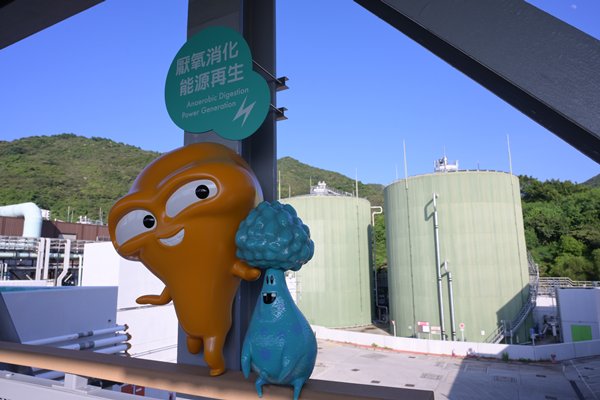Turning Food Waste Into Energy

Nestled in North Lantau is organic resources recovery centre O.PARK1, the first facility in Hong Kong which converts food waste into electricity. In March this year, the O.PARK1 Visitor Centre opened its doors to the public by offering guided tours.
Through the visitor centre, the Environmental Protection Department said it hopes to introduce the public to the Government’s strategies on food waste management, promote a food wise and waste less culture as well as encourage households and the commercial and industrial sectors to reduce food waste at source.
After arriving at the visitor centre and listening to a brief introduction from the tour guide, participants are led to the O · CLUB dome theatre to watch a series of informative computer animations.
Waste-to-energy
Iconic mascot Big Waster is presented in 360-degree projection and 3D mapping technology explaining how food waste increases the pressure on landfills, the process of converting food waste into electricity and introducing O.PARK1’s
facilities.
O.PARK1 adopts anaerobic digestion technology to convert food waste into biogas. The combined heat and power generation units then combust the biogas to generate electricity.
The department’s Assistant Environmental Protection Officer Daniel Chau noted that O.PARK1 can handle a maximum of 200 tonnes of food waste every day.
“Excluding the electricity required for the operation of O.PARK1, a maximum of 14 million kWh of electricity can be exported to the power grid of the electricity company every year,” Mr Chau added.
Green promotion
After leaving O · CLUB, participants follow the tour guide to three attractions. The first stop is a photo opportunity with a model of Big Waster at O · WELL. This is followed by a stroll along the O · LINK for a closer look at the facility’s equipment and systems, before ending the tour at the O · FARM rooftop garden to appreciate the horticulture.
Shrubs in O · FARM and all the gardening within the facilities are nurtured by compost products made in-house. Compost is the by-product generated from recycling food waste at O · PARK1.
O.PARK1 Visitor Centre Manager Monica Kwok explained that the facility distributes some of the compost to government departments and local landscaping companies. All tour participants also receive a bag of compost as a souvenir so they can share in the benefits of food waste recycling.
The visitor centre offers four guided tours daily, except on Tuesdays when it is closed. The tour lasts for about one and a half hours and is available in either Cantonese, Putonghua or English.
To book a free guided tour, visit the O.PARK1 website.
Fostering To Change A Childs Life
Since 2002, foster parents Mrs Ip and her husband have opened their hearts and home to nine foster children, including... Read more
Loving Caregivers Dote On Pandas
An An and Ke Ke, recently gifted to Hong Kong by the central government, met members of the public for the first time ... Read more
Open Lab Boosts Textile Sustainability
With the increasing awareness of environmental protection, people nowadays want to live a greener lifestyle, which mak... Read more
District Governance: Scheme Helps Ease Parental Pressure
One of the many challenges parents face is supporting their children with homework.One of those parents is mother of t... Read more
Nurturing Legal Talent Via Secondment
To boost Hong Kong as an international legal and dispute resolution services centre, the Department of Justice (DoJ) n... Read more
Protecting IP Rights Via Creativity
Earlier this month, hundreds of students of a primary school in Tin Shui Wai enjoyed an entertaining performance by a ... Read more

